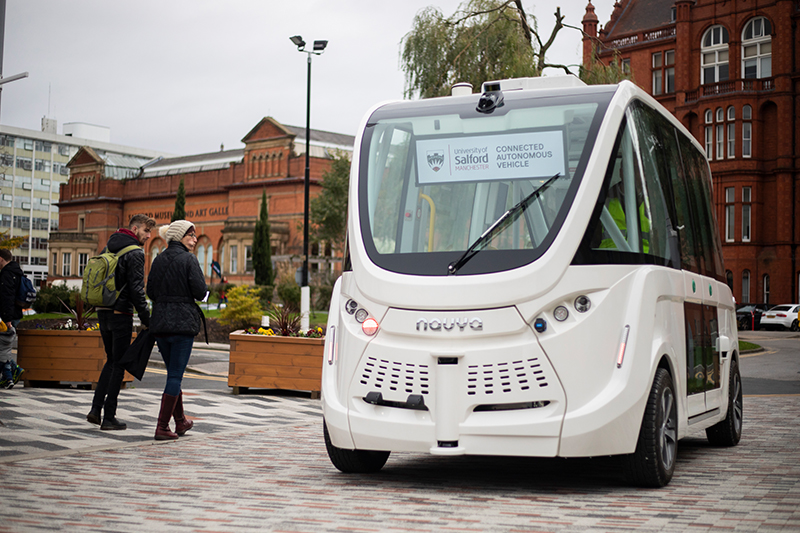Automotive and Autonomous Vehicle Technology Labs
We are in the midst of a seismic shift in the automotive industry.
For over a hundred years, if you wanted to get around you bought a car with an internal combustion engine. Nowadays, with sustainability the defining priority of the 21st century, the next generation of vehicles will be very different.
Which is why the University of Salford invested in creating a UK centre of excellence in future vehicles.
Commercial and grant funded research
Our commercial and grant funded research focuses on two strands of modern automotive engineering; reducing the emissions of conventional cars and pioneering research into hybrid, electric and autonomous vehicles.
Driverless vehicles
In addition to fundamental mechanical and electronic engineering issues, the advent of driverless vehicles has thrown up a number of real world problems that multi disciplinary teams of researchers from across the university are helping us to answer. For example, our work is supporting the DVLA to see how autonomous vehicles can be licensed, it’s helping insurers work out liability in the event of an accident and it’s addressing growing concerns over privacy and cyber security.
Specialist technical staff support
Supported by a number of specialist technical staff, the laboratories play a key role in Salford’s undergraduate and postgraduate engineering and acoustic programmes, offering students the opportunity to learn practical skills and explore solutions to commercial problems during their final year project.
Formula Salford Racing
It’s also home to the GreenPower Challenge and the Formula Salford Racing team where students work together to design, develop, build and race prototype cars in both hybrid/electric and conventionally powered formats.
Laboratories
Our laboratories are designed to feed into each other throughout each stage of a project. The research lab will usually see the start of a project and then we will test our findings in the simulation lab before moving into the final stage within the experimental lab where we can see our work run within a real world scenario.
Experimental laboratory
This research lab features a chassis dynamometer also known as a rolling road. It uses a roller assembly to simulate a road and can accept any single vehicle from a bicycle or motorcycle through to a car or van. It allows us to study the engine performance under strictly controlled speed, gradients and forces as well as enables a variety of emission tests.
We also have an advanced portable emissions measurement system (PEMS). We can measure gaseous and particle emissions as required by latest emission standards such as Euro 6 and, since it is used on a motor vehicle that is being driven during testing, provides us with real driving emissions (RDE) rather than that of the simulated road created by the chassis dynamometer.
As the only university in the UK to own a purpose built Level 4 driverless shuttle with 15 passengers, our Navya CAV lies at the heart of this lab and is helping us to explore our ambition of having the first autonomous public transport service running on a public road in the United Kingdom.
Supported by Salford City Council and Transport for Greater Manchester, the vehicle is currently used for research purposes on circuits around our campus.
This is allowing our research to focus on solving some of the real-world challenges of autonomous vehicles such as the psychology of perception and acceptance, accurate hazard detection, insurance, licensing and privacy.
One of the key issues for hybrid/electric and driverless vehicles is the battery life. The hardware and software required by driverless vehicles consumes significant power and the impact this has on time between charges is one of the main arguments between hybrid v fully electric autonomous vehicles. We are working with other university departments on the fluid dynamics of batteries to enhance cooling and reduce time to charge.
Simulation laboratory
The simulation lab runs several leading automotive industry software packages including AVL, a global technology partner to the automotive industry. Our simulation lab is also equipped with the Siemens PreScan a “physics-based simulation platform”. We use this platform to develop potential technology solutions for Advanced Driver Assistance Systems (ADAS) in connected and autonomous vehicles.
The lab also features a Husky unmanned ground vehicle by Clear Path Robotics. Customised to our research needs, this medium sized robotic development platform acts as a bridge between our research theories and their practical execution in the Navya CAV. It allows us to test out new routines and solutions that can then be easily ported over to the real applications.
Meet the team

Dr Meisam Babaie
A mechanical engineer and the Programme leader for Automotive and Autonomous Vehicle Technology. Meisam is the lead academic in modern automotive engineering research at University of Salford. He has strong research track record in energy system analysis and automotive emission control. His Current research include energy and transport data analytics, real driving emission reduction, future fusels, vehicle hybridization and real-world applications of connected and autonomous vehicles.
